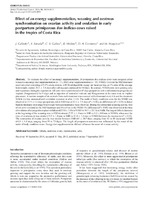Effect of an energy supplementation, weaning and oestrous synchronisation on ovarian activity and ovulation in early postpartum primiparous Bos indicus cows raised in the tropics of Costa Rica

Date
2016Author
Estrada, Sandra
Galina, Carlos
Molina, Rafael
Galindo-Badilla, Jaime Roberto
Metadata
Show full item recordAbstract
To evaluate the effect of an energy supplementation, 26 postpartum Bos indicus cows were assigned either
to receive an energy diet supplementation (n = 11, SSD) or no supplementation (n = 15, NSSD). Cows in the SSD treatment
received a diet consisting of 5.5% crude protein, 2.85 Mcal digestible energy per head per day, at 1% ratio of the average
bodyweight, started 23.5 3.4 days after calving and continued for 44 days. In contrast, NSSD cows were grazing only
native pastures during the experiment. All cows were synchronised at 65 days postpartum with a subcutaneous progestin ear
implant (Norgestomet) for 9 days and an injection of oestradiol valerate and Norgestomet at the same time as implant
placement. A random sample of six animals from each treatment was scanned with ultrasound every 6 h and the dominant
follicle (s) was measured until ovulation occurred or after 114 h. The nadir of body condition score for the NSSD was
observed at 37.5 3.4 days postpartum, while SSD was at 22.3 7.9 days (P < 0.01); no differences (P > 0.05) in dorsal
backfat thickness or average bodyweight between treatments were observed. During the ultrasound-scanning period, four
of six cows ovulated in the SSD treatment and five of six in the NSSD. No difference (P > 0.05) was observed at the time
of ovulation after progestin implant withdrawal (55.8 7.8 h inNSSDvs 94.5 21.7 h in SSD). The largest follicle diameter
at the beginning of the scanning was in SSD treatment (7.25 1.4 mm in SSD vs 5.0 0.8 mm in NSSD), whereas at the
time of ovulation, it was similar (15.2 1.8 mm in SSD vs 11.0 1.4 mm in NSSD) between the treatments (P > 0.05).
The resumption of ovarian activity was similar between SSD (69 20.7 days, ranging from 42 to 83 days) and NSSD
(69.8 6.4 days, ranging from 59 to 73 days). The length of postpartum anoestrus was influenced by the onset of the
nadir of body condition score. Energy diet supplementation did not influence the onset of ovarian activity.
Description
Artículo científico
Source
Animal Production ScienceShare
Metrics
Collections
- Artículos [26]

